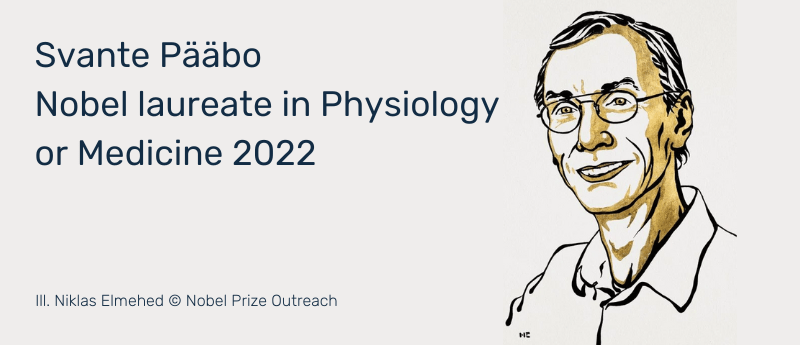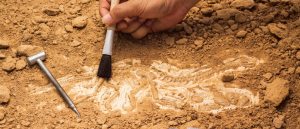
BioTechniques News
Tristan Free

The father of paleogenomics, Svante Pääbo (Max Planck Institute for Evolutionary Anthropology, Leipzig, Germany), has been awarded the 2022 Nobel Prize in Medicine for his pioneering work in the sequencing and analysis of extinct hominin DNA and his contributions to our understanding of human evolution [1].
The question of what makes humans unique and why we survived and flourished while other hominins faded into prehistory has fascinated scientists and the general public since evidence of our neanderthal ancestors was first uncovered in 1856. Initial archaeological evidence revealed that Homo sapiens initially evolved in Africa 300,000 years ago before populating the Middle East and the rest of the world. During this expansion, Homo sapiens encountered Neanderthals in Europe and western Asia who had appeared in these areas 400,000 years ago. Roughly 40,000 years after the expansion of Homo sapiens, the Neanderthals were extinct.
Many initially took this as proof of a Hobbesian view of humanity: the more self-interested, calculating and violent Homo sapiens gradually destroyed, outcompeted and replaced the incumbent populations of our ancestral relatives. But proving this theory and identifying precisely what differed between us and the Neanderthals was left to purely archaeological and paleontological investigations of the bones and settlements left behind by both species.
However, over the course of the last two decades, the field of paleogenomics has provided new insights that, paired with archaeological evidence, paint a different story. For these discoveries to come to light, the field needed a dramatic and rapid evolution.
The evolution of paleogenomics
Pääbo’s commitment to this field began early in his career working in the lab of Allan Willson at the University of California, Berkeley (CA, USA), undeterred by the significant challenges that sequencing ancient DNA presents. Degradation and contamination with human and microbe DNA are rife in these, often small, samples. So, to initially address these challenges he focussed on mitochondrial DNA, which is far more abundant.
After a move to the University of Munich (Germany), this approach eventually allowed Pääbo to sequence a region of mitochondrial DNA from a 40,000-year-old Neanderthal bone in 1997. His lab’s subsequent analysis of this sequence clearly marked these hominins as genetically distinct to modern humans [2]. However, the amount of information that can be extracted from mitochondrial DNA is limited in scope, due to its short length and small number of genes; to find out what made humanity successful, researchers needed to see the full Neanderthal genome.
It wasn’t until 2010, after Pääbo had established the Max Planck Institute for Evolutionary Anthropology, that the breakthrough came. After years of refining techniques for ancient DNA sequencing, capitalizing on the rapid increase in the efficiency of next-generation sequencing techniques, and collaborating with experts around the world Pääbo and his team successfully sequenced the first full-length Neanderthal genome.
 Ancient DNA extracted from dirt in microscopic fossil-like bone particles
Ancient DNA extracted from dirt in microscopic fossil-like bone particles
Researchers have developed a technique using polyester resin to extract ancient DNA from archaeological sediments, finding especially concentrated amounts of DNA in microscopic bone or feces particles.
Don’t forget the Denisovans
In between these two discoveries, an unexpected result from the Max Planck Institute for Evolutionary Anthropology, took the world by storm. A 40,000-year-old finger bone fragment from a cave in Siberia, containing astonishingly preserved DNA, was sequenced at the institute and analysis of the sequence revealed that it was unique to both human and Neanderthal DNA. In 2008, 152 years after the discovery of Neanderthals, a new species of hominins that co-existed with humans had been discovered. Named the Denisovans, after the Denisova cave that the bone was taken from, these hominins are now believed to have lived in the east of Eurasia until roughly 20,000 years ago with the oldest known bone sample dating back 200,000 years [5].
A better picture of human evolution
Now, the story of Homo sapiens expansion can be tracked, not just by hard soil evidence, but also by our present-day DNA. Using these gene sequences, researchers have also been able to determine that Homo sapiens diverged from Neanderthals 800,000 years ago. They have also been used to identify that modern-day humans with European and Asian decent have between 1-4% Neanderthal DNA, more than those with African descent. Meanwhile, many with South East Asian descent have up to 6% Denisovan DNA.
These collections of extinct hominin genes present in modern humans represent the gene flow from Denisovans and Neanderthals to Homo sapiens as our species spread across the world, interacting with these cultures and interbreeding with them. What’s more, subsequent archaeological research has revealed the exchange of humans and Neanderthal settlements on the same site over many years, suggesting that the decline of the latter took place over a much longer period of time, with the two species living alongside each other in the same regions.
Subsequent examinations of the genes that have been passed from our extinct hominin relatives have revealed several physiological impacts. These include the Denisovan version of EAPS1, which provides an advantage for high-altitude survival, while a series of Neanderthal variants localized to chromosome 3 is associated with an increased risk of hospitalization from COVID-19 [6].
 Modeling evolutionary history with ‘Neanderthalized’ brain organoids
Modeling evolutionary history with ‘Neanderthalized’ brain organoids
New organoid methods coupled with genomic studies have allowed for the creation of Neanderthalized brain organoids for the study of evolutionary history.
Speaking at the announcement of the prize regarding what made humans more successful, Gunilla Karlsson Hedestam (Karolinska Institute, Solna, Sweden) expounded the theory that, “humans developed large population sizes that the Neanderthals were essentially assimilated into.” In her view, being able to analyze the genes of humans and Neanderthals to identify the changes that allowed humans to become more social and to establish larger, more collaborative groups is one of the key applications of these hominin genomes.
Pääbo’s research group continues to produce new methods that improve the extraction and sequencing of ancient DNA [7] and the applications of these sequences are becoming more elaborate and creative, with a recent research effort culminating in the creation of a ‘Neanderthalized’ brain organoid to better understand the differences between our species. The impacts of his work will be wide-ranging and in medicine and health, but could also help provide a more optimistic take on what made humans unique and more successful than our extinct cousins. Perhaps co-operation and not calculation is to credit for humanity’s survival.
The post Who won the 2022 Nobel Prize in Medicine? appeared first on BioTechniques.
Full BioTechniques Article here
Powered by WPeMatico
